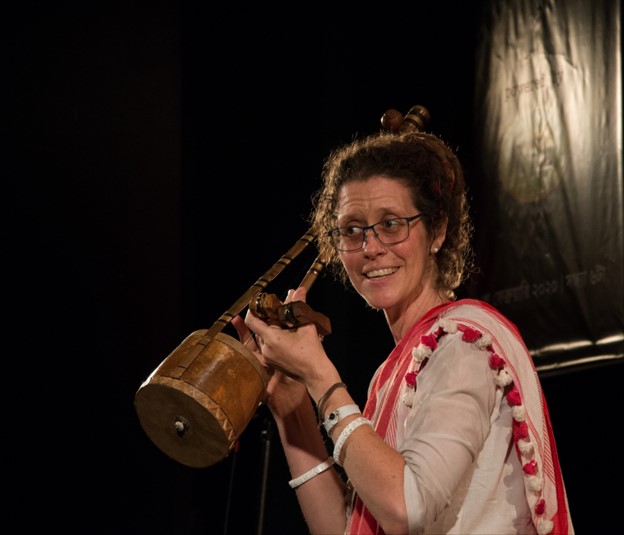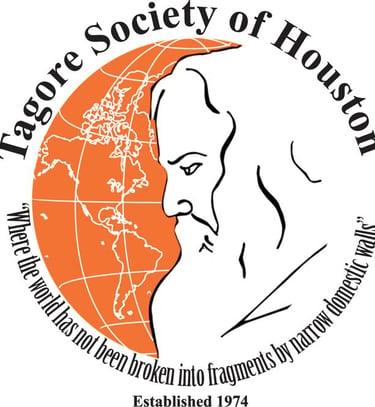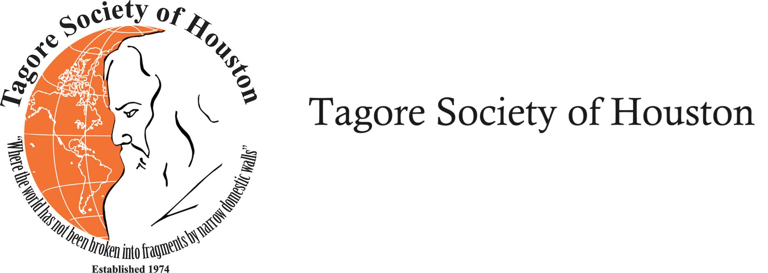!!!!! Thank You Houston for the Overwhelming Turnout for the 2025 Tagore Talk !!!!
Your support & donation, helps TSH continue to be a vibrant hub for cultural exchange for generations to come.
Bringing Bengal’s Baul music to Bayou City ...
Saraswati (Sarah) Cutler
Saraswati (Sarah) Cutler has been learning Baul songs from Parvathy Baul (www.parvathybaul.com) and other Baul masters since 2017. As a student at Mount Holyoke College, she traveled to Shantineketan in 2003 for a month to explore the ideas of interdisciplinary education found in the philosophy of Rabindranath Tagore. Tagore’s themes of universality, education in the mother-tongue, union between the arts and sciences, east and west, and the outdoor classroom had deep resonance to this young biology major. While her visit was brief, a love of the culture and people of West Bengal took root in her heart. Fully intending to return to India soon after graduating from college, it took 15 years, and many adventures, before she found herself again in Bengal.
Exploring themes of outdoor education brought the young graduate to work in a wilderness therapy setting. From there, her own self searching took over leading her to study Yoga. Moving to New Mexico, she immersed in Ayurvedic Self-Care and Nutrition; Polarity Therapy, Cranial Sacral Therapy, and eventually Massage. She apprenticed with death and the end of life transition, and became a well loved retreat cook. All the while, her spiritual seeking and life long commitment to growth, healing, and connection brought her into community and natural living situations where life taught her. Her own practice deepended. In 2017 circumstances conspired for her to meet Parvathy Baul at a USA based retreat near Birmingham, Alabama. Touching the movement and song of the Baul practice, and resonating with the yoga inherent in the poetry, Saraswati put out a prayer to go deeper. That fall, finally, she traveled back to India, and in January 2018 sat among the Baul Masters Parvathy Maa had gathered at her center, Santan Siddhashram. It was a coming together of many themes.
Saraswati then began to immerse a little at a time whenever she could in the Baul Songs, and to serve in a volunteer capacity as a sevak for Santan Siddhashram’s mission to preserve and share the Baul tradition. A self professed slow leaner, Saraswati suspects it is in part her refusal to give up even tho it took her three years to fully sing her first song, that permit her the continued opportunity to study and practice at the feet of Parvathy Baul, and others such as Aklima Fakarini, Andando Das Baul, Deb Das Baul, Kaniai Mohan Das Baul, Laksman Das Baul, and others. The humility, kindness and generosity of these masters and gurus is a beauty to be shared--and opportunities like this one to offer Baul songs to open hearted audiences is a great joy. Gratitude and pranams. Guru kripa hi kevelam.
Acknowledgements:
Without the grace and blessings of my Gurus and teachers none of this would be possible. All errors are my own and all success is at their holy feet and the feet of their gurus back to the primordial beginning. Special thanks to Parvathy Baul, the beloveds closest in to my heart without whom the path would be impossible, all of my gurubon and gurubhai, and for the extra tutorial by Dr. Uttara Chousalkar. Thanks also to Dr. Indira Peterson, professor emeritus Mount Holyoke College, for the class that introduced me to Tagore and first got me to India.


Initial program notes for Tagore Society of Houston:
Starting with a short passage from the Rig Veda (X191), Samgacchadhvam is sung to a tune written by Tagore. This passage sets the tone both of Rabindranath Tagore’s lifelong call for unity and harmony across seeming divides. In translation:
“Come together! Speak together!
Let our minds be all of one accord,
just as the gods of old sat in Harmony to worship.
Let our speech be one, united our voices!
May our minds be in Union with the thoughts of the wise. Sharing a common purpose, let us worship as one.
Let our aim be one and single!
Let our hearts be joined as one.
United be our thoughts.
At Peace with All, may be be together in Harmony.”
Samgacchadhvam (Isha Basya) from Rig Veda X 191. Tune by Rabindranath Tagore
Sam gacchadhvam Sam vadah vam
Sam vo manam si janatam
Deva bhagam yatha purve
San jana na upasate
Samano mantra / Samiti sama ni
Samano, mana Saha cittamesam
Samanam, mantrambhi mantraye
va samanena vo havisa juhomi, juhomi
Samani va a kuti Samana hridyani vah
Samanamastu vo mano yatha
vasu sahasati
It is from this place of unity that we move onto four Baul songs interspersed with personal stories linking the themes of the songs with Tagore’s themes. The songs themselves stand alone in the Baul tradition, much loved and respected by Tagore, and yet the themes and the heart of the Baul can add to the celebration of Tagore’s universal theme of love.
Guru Naam Koro Shodona’s plaintive tune brings one on the inner journey of sadhana on the beloved name of the Guru. Those familiar with Tagore’s works may already find that they understand the themes in their heart. Moving on to the great guru of the Bauls, Chaitanya Mahaprabhu, Tomar Nam Sunescche Gaur, reminds us that even in hardship and in sweetness all we have is this connection and our own longing. Emon Premere Nodite Shoi Go is a love song that also reminds us of our longing to merge into the Beloved and our own hesitation, a universal theme. And finally a song to the Devi, Ek Bar Birajo Go Ma, reminding us that all phenomena are connected as we make a place for Maa in our own heart lotus seat. The themes are universal, connective, and deeply grounded in the landscape of West Bengal.
It is likely, in true Baul fashion, we will end in praise and union together.
Tagore’s emphasis on deep immersion in one’s own tradition, while also recognizing the universal connection between people and between traditions is what first inspired me as a college student.I have found inside the Baul songs and practice a way to embody this longing undoing the separation that ideas of East or West, Bengali or American, Student or Master engender.It is my hope with this performance to cross all of these boundaries and invite the audience into the heart of love and devotion and longing of the Baul songs, and in turn let the love and poetry of Tagore that the rest of the celebration highlights blossom in the consciousness of all.
Tagore Society of Houston
13303 Hartford Bay Trl Cypress, TX 77429
CONNECT WITH US
Tagore Society of Houston is a non-profit, tax-exempt charitable organization (Tax ID number 76-0447299) under Section 501(c)(3) of the Internal Revenue Code. Donations are tax-deductible as allowed by law.
© Copyright TSH, All Rights Reserved


CONTACT US
281-386-7224
